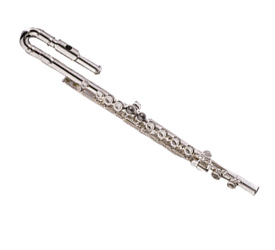In its simplest form, a flute is an instrument with a hollow body into which air is blown. The airstream then strikes the edge of an opening at an end or side of the instrument. A specific pitch is created by the shape of the flute, the length of the tube or the volume of the vessel, and any open holes. They can be made out of a variety of materials, the most common being metal and wood. The (transverse) flute we are used to and most popular in Western music is actually the least commonly known/used flute worldwide.
History
The flute has had quite the evolution over time.
- Varying forms of flutes are found in almost every region the world except Australia and Greenland.
- Many early flutes looked more like modern recorders.
- Different styles of flutes and variations in material and size appeared over time.
- Music of any time period was created to include the popular flute of the day.
- 1722 - Famous flutist and composer Quantz adds tuning cork in headjoint and C# key on footjoint
- 1726 - E-flat & D-sharp keys added on footjoint (two separate keys) by Quantz while he was in Paris
- 1760 - G#, B-flat, & F keys added by London makers Florio, Gedney, & Potter
- 1782 - Maker J.H. Ribock adds closed C key
- 1838 - Buffet and collaborator Coche, add D# trill key and "Dorus" G# key
- and more...
Ethnic Relative
One of the most widely used instruments of the flute family is the panpipe. It is made of many tubes/pipes of individual pitch grouped together in a clump or "raft". Each pipe is stopped at one end and blown over the other; there is no mouthpiece. They are used worldwide, though they are most popular in countries in the Pacific region.

Types of Modern Flutes
bass flute in C

alto flute in G

concert flute in C

tenor flute (in B flat)

soprano flute in E flat

treble flute in G
piccolo

Examples of Flute Music
flute choir at Wartburg
jazz:
classical:
No comments:
Post a Comment